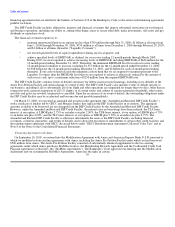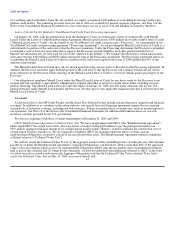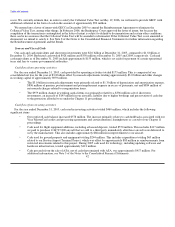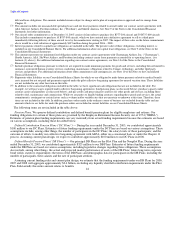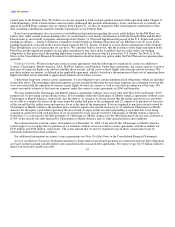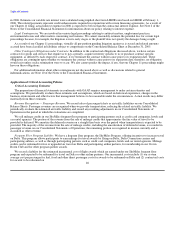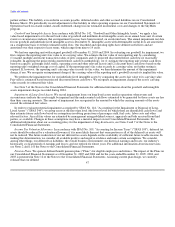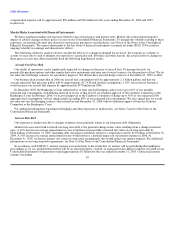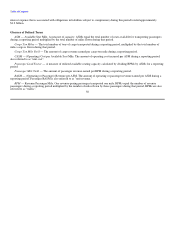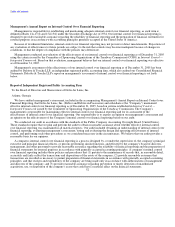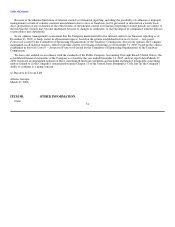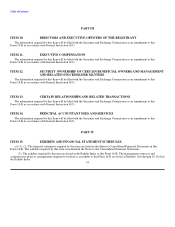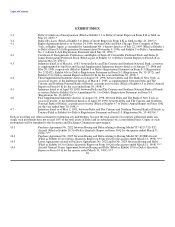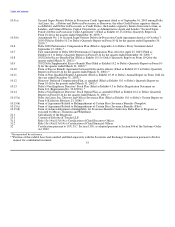Delta Airlines 2005 Annual Report Download - page 52
Download and view the complete annual report
Please find page 52 of the 2005 Delta Airlines annual report below. You can navigate through the pages in the report by either clicking on the pages listed below, or by using the keyword search tool below to find specific information within the annual report.
Table of Contents
partner airlines. The liability is recorded in accounts payable, deferred credits and other accrued liabilities on our Consolidated
Balance Sheets. We periodically record adjustments to this liability in other operating expenses on our Consolidated Statements of
Operations based on awards earned, awards redeemed, changes in our estimated incremental costs and changes to the SkyMiles
program.
Goodwill and Intangible Assets. In accordance with SFAS No. 142, "Goodwill and Other Intangible Assets," we apply a fair
value-based impairment test to the net book value of goodwill and indefinite-lived intangible assets on an annual basis and, if certain
events or circumstances indicate that an impairment loss may have been incurred, on an interim basis. The annual impairment test date
for our goodwill and indefinite-lived intangible assets is December 31. Intangible assets with determinable useful lives are amortized
on a straight-line basis over their estimated useful lives. Our leasehold and operating rights have definite useful lives and are
amortized over their respective lease terms, which range from nine to 19 years.
We had one reporting unit with assigned goodwill at December 31, 2005 and 2004. In evaluating our goodwill for impairment, we
first compare the reporting unit's fair value to its carrying value. We estimate the fair value of our reporting unit by considering
(1) market multiple and recent transaction values of peer companies and (2) projected discounted future cash flows if reasonably
estimable. In applying the projected discounted future cash flow methodology, we (1) estimate the reporting unit's future cash flows
based on capacity, passenger yield, traffic, operating costs and other relevant factors and (2) discount those cash flows based on the
reporting unit's weighted average cost of capital. If the reporting unit's fair value exceeds its carrying value, no further testing is
required. If, however, the reporting unit's carrying value exceeds its fair value, we then determine the amount of the impairment
charge, if any. We recognize an impairment charge if the carrying value of the reporting unit's goodwill exceeds its implied fair value.
We perform the impairment test for our indefinite-lived intangible assets by comparing the asset's fair value to its carrying value.
Fair value is estimated based on projected discounted future cash flows. We recognize an impairment charge if the asset's carrying
value exceeds its estimated fair value.
See Note 7 of the Notes to the Consolidated Financial Statements for additional information about the goodwill and intangible
assets impairment charges recorded during 2004.
Impairment of Long-Lived Assets. We record impairment losses on long-lived assets used in operations when events and
circumstances indicate the assets might be impaired and the undiscounted cash flows estimated to be generated by those assets are less
than their carrying amounts. The amount of impairment loss recognized is the amount by which the carrying amounts of the assets
exceed the estimated fair values.
In order to evaluate potential impairment as required by SFAS No. 144, "Accounting for the Impairment or Disposal of Long-
Lived Assets" ("SFAS 144"), we group assets at the fleet type level (the lowest level for which there are identifiable cash flows) and
then estimate future cash flows based on assumptions involving projections of passenger yield, fuel costs, labor costs and other
relevant factors. Aircraft fair values are estimated by management using published sources, appraisals and bids received from third
parties, as available. Changes in these assumptions may have a material impact on our Consolidated Financial Statements. For
additional information about our accounting policy for the impairment of long-lived assets, see Notes 2 and 7 of the Notes to the
Consolidated Financial Statements.
Income Tax Valuation Allowance. In accordance with SFAS No. 109, "Accounting for Income Taxes" ("SFAS 109"), deferred tax
assets should be reduced by a valuation allowance if it is more likely than not that some portion or all of the deferred tax assets will
not be realized. The future realization of our net deferred tax assets depends on the availability of sufficient future taxable income. In
making this determination, we consider all available positive and negative evidence and make certain assumptions. We consider,
among other things, our deferred tax liabilities; the overall business environment; our historical earnings and losses; our industry's
historically cyclical periods of earnings and losses; and our outlook for future years. For additional information about income taxes,
see Notes 2 and 11 of the Notes to the Consolidated Financial Statements.
Pension Plans. We sponsor defined benefit pension plans ("Plans") for eligible employees and retirees. The impact of the Plans on
our Consolidated Financial Statements as of December 31, 2005 and 2004 and for the years ended December 31, 2005, 2004, and
2003 is presented in Note 12 of the Notes to the Consolidated Financial Statements. Assuming current plan design, we currently
estimate that our defined 47




